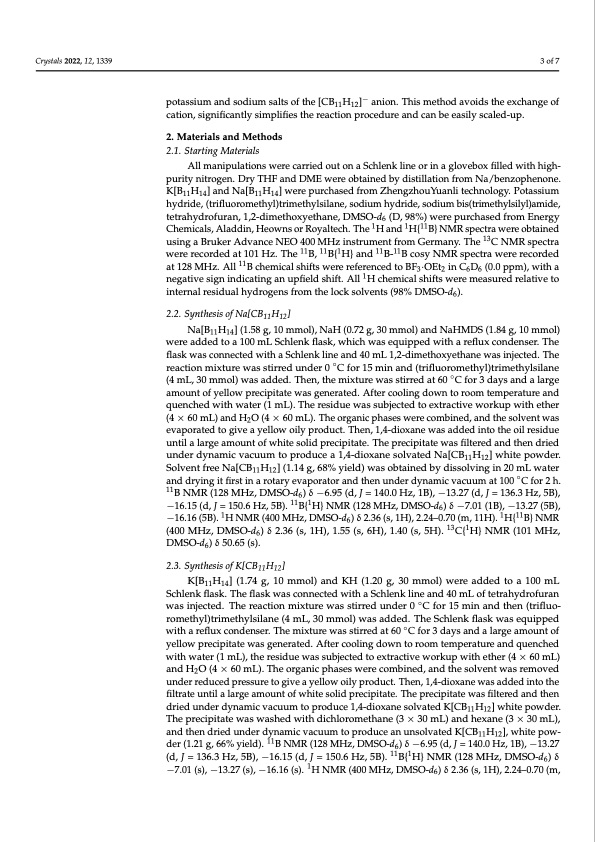
PDF Publication Title:
Text from PDF Page: 003
Crystals 2022, 12, 1339 3 of 7 potassium and sodium salts of the [CB11H12]− anion. This method avoids the exchange of cation, significantly simplifies the reaction procedure and can be easily scaled-up. 2. Materials and Methods 2.1. Starting Materials All manipulations were carried out on a Schlenk line or in a glovebox filled with high- purity nitrogen. Dry THF and DME were obtained by distillation from Na/benzophenone. K[B11H14] and Na[B11H14] were purchased from ZhengzhouYuanli technology. Potassium hydride, (trifluoromethyl)trimethylsilane, sodium hydride, sodium bis(trimethylsilyl)amide, tetrahydrofuran, 1,2-dimethoxyethane, DMSO-d6 (D, 98%) were purchased from Energy Chemicals, Aladdin, Heowns or Royaltech. The 1H and 1H{11B} NMR spectra were obtained using a Bruker Advance NEO 400 MHz instrument from Germany. The 13C NMR spectra were recorded at 101 Hz. The 11B, 11B{1H} and 11B-11B cosy NMR spectra were recorded at 128 MHz. All 11B chemical shifts were referenced to BF3·OEt2 in C6D6 (0.0 ppm), with a negative sign indicating an upfield shift. All 1H chemical shifts were measured relative to internal residual hydrogens from the lock solvents (98% DMSO-d6). 2.2. Synthesis of Na[CB11H12] Na[B11H14] (1.58 g, 10 mmol), NaH (0.72 g, 30 mmol) and NaHMDS (1.84 g, 10 mmol) were added to a 100 mL Schlenk flask, which was equipped with a reflux condenser. The flask was connected with a Schlenk line and 40 mL 1,2-dimethoxyethane was injected. The reaction mixture was stirred under 0 ◦C for 15 min and (trifluoromethyl)trimethylsilane (4 mL, 30 mmol) was added. Then, the mixture was stirred at 60 ◦C for 3 days and a large amount of yellow precipitate was generated. After cooling down to room temperature and quenched with water (1 mL). The residue was subjected to extractive workup with ether (4 × 60 mL) and H2O (4 × 60 mL). The organic phases were combined, and the solvent was evaporated to give a yellow oily product. Then, 1,4-dioxane was added into the oil residue until a large amount of white solid precipitate. The precipitate was filtered and then dried under dynamic vacuum to produce a 1,4-dioxane solvated Na[CB11H12] white powder. Solvent free Na[CB11H12] (1.14 g, 68% yield) was obtained by dissolving in 20 mL water and drying it first in a rotary evaporator and then under dynamic vacuum at 100 ◦C for 2 h. 11B NMR (128 MHz, DMSO-d6) δ −6.95 (d, J = 140.0 Hz, 1B), −13.27 (d, J = 136.3 Hz, 5B), −16.15 (d, J = 150.6 Hz, 5B). 11B{1H} NMR (128 MHz, DMSO-d6) δ −7.01 (1B), −13.27 (5B), −16.16 (5B). 1H NMR (400 MHz, DMSO-d6) δ 2.36 (s, 1H), 2.24–0.70 (m, 11H). 1H{11B} NMR (400 MHz, DMSO-d6) δ 2.36 (s, 1H), 1.55 (s, 6H), 1.40 (s, 5H). 13C{1H} NMR (101 MHz, DMSO-d6) δ 50.65 (s). 2.3. Synthesis of K[CB11H12] K[B11H14] (1.74 g, 10 mmol) and KH (1.20 g, 30 mmol) were added to a 100 mL Schlenk flask. The flask was connected with a Schlenk line and 40 mL of tetrahydrofuran was injected. The reaction mixture was stirred under 0 ◦C for 15 min and then (trifluo- romethyl)trimethylsilane (4 mL, 30 mmol) was added. The Schlenk flask was equipped with a reflux condenser. The mixture was stirred at 60 ◦C for 3 days and a large amount of yellow precipitate was generated. After cooling down to room temperature and quenched with water (1 mL), the residue was subjected to extractive workup with ether (4 × 60 mL) and H2O (4 × 60 mL). The organic phases were combined, and the solvent was removed under reduced pressure to give a yellow oily product. Then, 1,4-dioxane was added into the filtrate until a large amount of white solid precipitate. The precipitate was filtered and then dried under dynamic vacuum to produce 1,4-dioxane solvated K[CB11H12] white powder. The precipitate was washed with dichloromethane (3 × 30 mL) and hexane (3 × 30 mL), and then dried under dynamic vacuum to produce an unsolvated K[CB11H12], white pow- der (1.21 g, 66% yield). 11B NMR (128 MHz, DMSO-d6) δ −6.95 (d, J = 140.0 Hz, 1B), −13.27 (d, J = 136.3 Hz, 5B), −16.15 (d, J = 150.6 Hz, 5B). 11B{1H} NMR (128 MHz, DMSO-d6) δ −7.01 (s), −13.27 (s), −16.16 (s). 1H NMR (400 MHz, DMSO-d6) δ 2.36 (s, 1H), 2.24–0.70 (m,PDF Image | Efficient Way to Directly Synthesize Unsolvated Alkali Metal

PDF Search Title:
Efficient Way to Directly Synthesize Unsolvated Alkali MetalOriginal File Name Searched:
crystals-12-01339.pdfDIY PDF Search: Google It | Yahoo | Bing
Product and Development Focus for Salgenx
Redox Flow Battery Technology: With the advent of the new USA tax credits for producing and selling batteries ($35/kW) we are focussing on a simple flow battery using shipping containers as the modular electrolyte storage units with tax credits up to $140,000 per system. Our main focus is on the salt battery. This battery can be used for both thermal and electrical storage applications. We call it the Cogeneration Battery or Cogen Battery. One project is converting salt (brine) based water conditioners to simultaneously produce power. In addition, there are many opportunities to extract Lithium from brine (salt lakes, groundwater, and producer water).Salt water or brine are huge sources for lithium. Most of the worlds lithium is acquired from a brine source. It's even in seawater in a low concentration. Brine is also a byproduct of huge powerplants, which can now use that as an electrolyte and a huge flow battery (which allows storage at the source).We welcome any business and equipment inquiries, as well as licensing our flow battery manufacturing.| CONTACT TEL: 608-238-6001 Email: greg@salgenx.com | RSS | AMP |